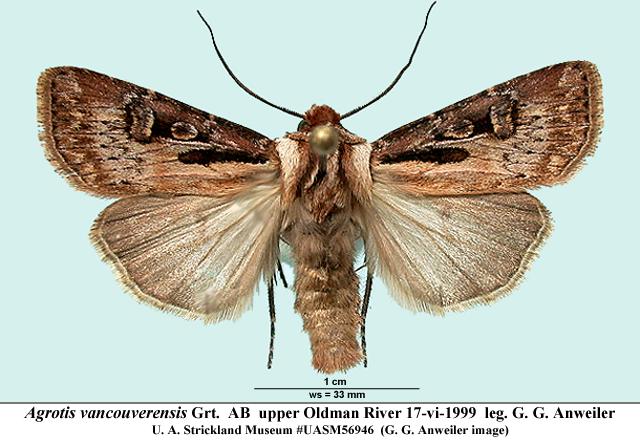Species Details
Agrotis vancouverensis
University of Alberta E.H. Strickland Entomological Museum Read more about this collection »
Common NameVancouver Dart
SeasonalityAdults in late spring and early summer, with the main flight in June
IdentificationA medium size moth (forewing length about 33 mm) with light and dark reddish brown forewings. The subterminal area in particular is usually lighter brown, and is crossed by poorly defined jagged light and dark lines. The orbicular and reniform spots are well defined, with the area before and between them blackish. The basal dash-claviform spot is prominent and filled with black scales. Hidwings brown. Very similar to and often confused with A. obliqua, which is slightly larger, darker, and less streaky appearing. Specimens of vancouverensis and obliqua are difficult to separate, and are frequently found misidentified in collections.
Scientific Name
Agrotis vancouverensis
Common Name
Vancouver Dart
Seasonality
Adults in late spring and early summer, with the main flight in June
Identification
A medium size moth (forewing length about 33 mm) with light and dark reddish brown forewings. The subterminal area in particular is usually lighter brown, and is crossed by poorly defined jagged light and dark lines.…
A medium size moth (forewing length about 33 mm) with light and dark reddish brown forewings. The subterminal area in particular is usually lighter brown, and is crossed by poorly defined jagged light and dark lines. The orbicular and reniform spots are well defined, with the area before and between them blackish. The basal dash-claviform spot is prominent and filled with black scales. Hidwings brown. Very similar to and often confused with A. obliqua, which is slightly larger, darker, and less streaky appearing. Specimens of vancouverensis and obliqua are difficult to separate, and are frequently found misidentified in collections.
Life History
Agrotis vancouverensis is single brooded, with adults in late spring and early summer, with the main flight in June. They are nocturnal and come to light. The larva is described by both Crumb (1956) and Lafontaine (2004).
Agrotis vancouverensis is single brooded, with adults in late spring and early summer, with the main flight in June. They are nocturnal and come to light. The larva is described by both Crumb (1956) and Lafontaine (2004).
Diet Info
Larvae have been collected on both strawberry and clover, and are likely generalists on low growing herbs.
Range
Agrotis vancouverensis has a western distribution, and is absent from most of the Great Plains and Great Basin regions. In Alberta is has been collected widely in the parklands, foothills and mountains, and in wooded…
Agrotis vancouverensis has a western distribution, and is absent from most of the Great Plains and Great Basin regions. In Alberta is has been collected widely in the parklands, foothills and mountains, and in wooded parts of the grasslands region.
Notes
The Vancouver Dart is the most common and most variable species of Agrotis in western North America.
References
Author
Lafontaine, J. Donald
Title
Noctuoidea : Noctuidae (part)
Publication Date
2004
Pages
385 pp.
Specimen Information
There are 295 specimens of this Species.
BIRD37650 - Agrotis vancouverensis
University of Alberta E.H. Strickland Entomological Museum
Place CollectedCanada: Alberta, Winfield
Collected ByBird, C. D.
Date Collected2014-06-27
